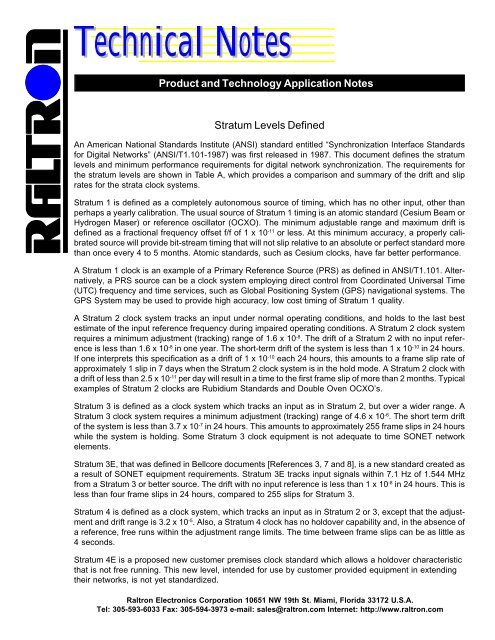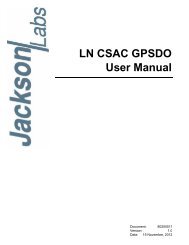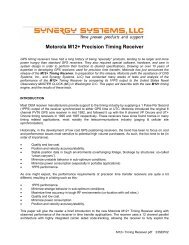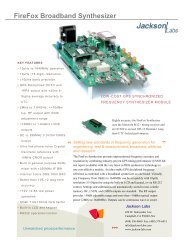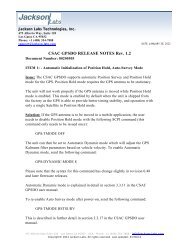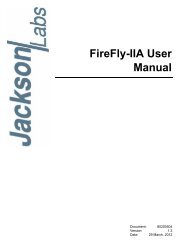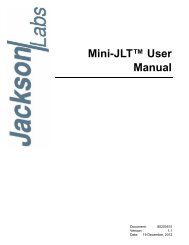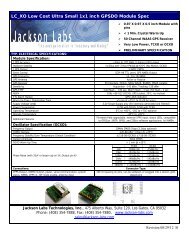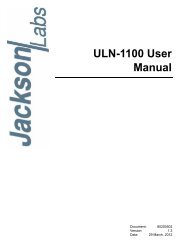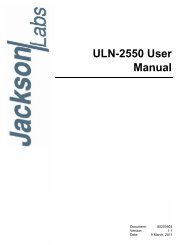Stratum Levels Defined - Jackson Labs Technologies, Inc.
Stratum Levels Defined - Jackson Labs Technologies, Inc.
Stratum Levels Defined - Jackson Labs Technologies, Inc.
You also want an ePaper? Increase the reach of your titles
YUMPU automatically turns print PDFs into web optimized ePapers that Google loves.
Technical Notes<br />
Product and Technology Application Notes<br />
<strong>Stratum</strong> <strong>Levels</strong> <strong>Defined</strong><br />
An American National Standards Institute (ANSI) standard entitled “Synchronization Interface Standards<br />
for Digital Networks” (ANSI/T1.101-1987) was first released in 1987. This document defines the stratum<br />
levels and minimum performance requirements for digital network synchronization. The requirements for<br />
the stratum levels are shown in Table A, which provides a comparison and summary of the drift and slip<br />
rates for the strata clock systems.<br />
<strong>Stratum</strong> 1 is defined as a completely autonomous source of timing, which has no other input, other than<br />
perhaps a yearly calibration. The usual source of <strong>Stratum</strong> 1 timing is an atomic standard (Cesium Beam or<br />
Hydrogen Maser) or reference oscillator (OCXO). The minimum adjustable range and maximum drift is<br />
defined as a fractional frequency offset f/f of 1 x 10 -11 or less. At this minimum accuracy, a properly calibrated<br />
source will provide bit-stream timing that will not slip relative to an absolute or perfect standard more<br />
than once every 4 to 5 months. Atomic standards, such as Cesium clocks, have far better performance.<br />
A <strong>Stratum</strong> 1 clock is an example of a Primary Reference Source (PRS) as defined in ANSI/T1.101. Alternatively,<br />
a PRS source can be a clock system employing direct control from Coordinated Universal Time<br />
(UTC) frequency and time services, such as Global Positioning System (GPS) navigational systems. The<br />
GPS System may be used to provide high accuracy, low cost timing of <strong>Stratum</strong> 1 quality.<br />
A <strong>Stratum</strong> 2 clock system tracks an input under normal operating conditions, and holds to the last best<br />
estimate of the input reference frequency during impaired operating conditions. A <strong>Stratum</strong> 2 clock system<br />
requires a minimum adjustment (tracking) range of 1.6 x 10 -8 . The drift of a <strong>Stratum</strong> 2 with no input reference<br />
is less than 1.6 x 10 -8 in one year. The short-term drift of the system is less than 1 x 10 -10 in 24 hours.<br />
If one interprets this specification as a drift of 1 x 10 -10 each 24 hours, this amounts to a frame slip rate of<br />
approximately 1 slip in 7 days when the <strong>Stratum</strong> 2 clock system is in the hold mode. A <strong>Stratum</strong> 2 clock with<br />
a drift of less than 2.5 x 10 -11 per day will result in a time to the first frame slip of more than 2 months. Typical<br />
examples of <strong>Stratum</strong> 2 clocks are Rubidium Standards and Double Oven OCXO’s.<br />
<strong>Stratum</strong> 3 is defined as a clock system which tracks an input as in <strong>Stratum</strong> 2, but over a wider range. A<br />
<strong>Stratum</strong> 3 clock system requires a minimum adjustment (tracking) range of 4.6 x 10 -6 . The short term drift<br />
of the system is less than 3.7 x 10 -7 in 24 hours. This amounts to approximately 255 frame slips in 24 hours<br />
while the system is holding. Some <strong>Stratum</strong> 3 clock equipment is not adequate to time SONET network<br />
elements.<br />
<strong>Stratum</strong> 3E, that was defined in Bellcore documents [References 3, 7 and 8], is a new standard created as<br />
a result of SONET equipment requirements. <strong>Stratum</strong> 3E tracks input signals within 7.1 Hz of 1.544 MHz<br />
from a <strong>Stratum</strong> 3 or better source. The drift with no input reference is less than 1 x 10 -8 in 24 hours. This is<br />
less than four frame slips in 24 hours, compared to 255 slips for <strong>Stratum</strong> 3.<br />
<strong>Stratum</strong> 4 is defined as a clock system, which tracks an input as in <strong>Stratum</strong> 2 or 3, except that the adjustment<br />
and drift range is 3.2 x 10 -5 . Also, a <strong>Stratum</strong> 4 clock has no holdover capability and, in the absence of<br />
a reference, free runs within the adjustment range limits. The time between frame slips can be as little as<br />
4 seconds.<br />
<strong>Stratum</strong> 4E is a proposed new customer premises clock standard which allows a holdover characteristic<br />
that is not free running. This new level, intended for use by customer provided equipment in extending<br />
their networks, is not yet standardized.<br />
Raltron Electronics Corporation 10651 NW 19th St. Miami, Florida 33172 U.S.A.<br />
Tel: 305-593-6033 Fax: 305-594-3973 e-mail: sales@raltron.com Internet: http://www.raltron.com
The <strong>Stratum</strong> Hierarchy<br />
A <strong>Stratum</strong> 1 clock may control strata 2, 3E, 3, 4E, or 4 clocks. A <strong>Stratum</strong> 2 clock may drive strata 2, 3E, 3, 4E, or 4<br />
clocks. A <strong>Stratum</strong> 3E clock may drive strata 3E, 3, 4E or 4 clocks. A <strong>Stratum</strong> 3 clock may drive strata 3, 4E or 4 clocks.<br />
A <strong>Stratum</strong> 4E or 4 clock is not recommended as a source of timing for any other clock system.<br />
Because of the narrower capture and adjustment range of the higher strata clock systems (2 is higher than 3, and so<br />
on), driving a <strong>Stratum</strong> 2 clock from a <strong>Stratum</strong> 3E or 3 clock is not recommended. In fact, it will not work under some<br />
transmission impaired conditions. Also, extreme care must be taken in network applications where more than one<br />
<strong>Stratum</strong> 1 source is used to ensure that these sources are accurate and traceable to some other standard. Another<br />
standard commonly used to check on a <strong>Stratum</strong> 1 clock source’s accuracy is the GPS System. A GPS receiver can also<br />
be used directly as a source of <strong>Stratum</strong> 1 quality.<br />
<strong>Stratum</strong> 1 clock administration, operation, and maintenance can be a costly effort. Atomic sources may not have long<br />
maintenance-free operating intervals, and may experience failures without giving an indication that the source is off<br />
frequency. In addition, if a <strong>Stratum</strong> 1 source of timing is shown to be inaccurate, the network must be able to accept<br />
another network’s timing until the problem is corrected. Thus, GPS is attractive in order to assure accuracy and minimize<br />
cost.<br />
Table A: <strong>Stratum</strong> Clock Requirements and Hierarchy<br />
<strong>Stratum</strong> Accuracy/Adjust Range Pull-In-Range Stability Time To First Frame Slip *<br />
1 1 x 10 -11 N/A N/A 72 Days<br />
2 1.6 x 10 -8 Must be capable of synchronizing to<br />
clock with accuracy of +/-1.6 x 10 -8 1 x 10 -10 /day 7 Days<br />
3E 1.0 x 10 -6 Must be capable of synchronizing to<br />
clock with accuracy of +/-4.6 x 10 -6 1 x 10 -8 /day 3.5 Hours<br />
3 4.6 x 10 -6 Must be capable of synchronizing to<br />
clock with accuracy of +/-4.6 x 10 -6 3.7 x 10 -7 /day 6 Minutes (255 in 24 Hrs)<br />
4E 32 x 10 -6 Must be capable of synchronizing to<br />
clock with accuracy of +/-32 x 10 -6 Same as Accuracy Not Yet Specified<br />
4 32 x 10 -6 Must be capable of synchronizing to<br />
clock with accuracy of +/-32 x 10 -6 Same as Accuracy N/A<br />
Notes:<br />
* To calculate slip rate from drift, one assumes a frequency offset equal to the above drift in 24 hours, which accumulates bit slips<br />
until 193 bits have been accumulated. Drift rates for various atomic and crystal oscillators are well known, and are not usually<br />
linear or not necessarily continually increasing.<br />
A Network Slip, What Happens<br />
If a frame slip occurs due to a clock system in the holdover condition, what is the penalty Does the connected equipment<br />
stop working Not usually. Voice equipment tends to re-acquire frame synchronization quickly, resulting in a pop<br />
or click, which is not usually a problem. Data circuits lose some number of bits depending on the data rate being<br />
transmitted, and on whether or not forward error correction is being used.<br />
Some multiplex equipment that provides add and drop services interrupt all output trunks while a new source of synchronization<br />
is acquired. Such interruptions, if due to circuit noise, may render a network temporarily useless, as the slip<br />
causes further slips downstream (error or slip multiplication).<br />
A clock system provides a stable frequency source during circuit impairments. The connected equipment will not be<br />
affected until the clock holdover drift results in a slip. A stable clock will change a network that experiences problems<br />
two or three times a day to one that maintains timing through a major trunk outage. The network will continue to operate<br />
without impairment until the outage is repaired, as long as the repair time is comparable to the time of the first frame slip<br />
(see Table A).<br />
Since occasional slips will always occur, the best one can do is to minimize their rate of occurrence. Through careful<br />
network engineering of the clock systems, near perfect timing may be achieved at a reasonable cost with excellent<br />
reliability and maintainability.<br />
Raltron Electronics Corporation 10651 NW 19th St. Miami, Florida 33172 U.S.A.<br />
Tel: 305-593-6033 Fax: 305-594-3973 e-mail: sales@raltron.com Internet: http://www.raltron.com


